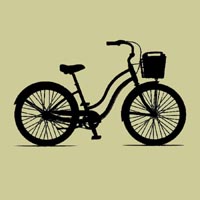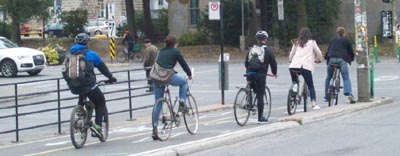How to shift gears on a vintage bicycle

General gear shifting tips
- On all bikes except vintage 3 speeds, you must keep on pedaling forward while shifting gears. The chain must be moving the go from one gear to another. It's normal to hear some grinding noise. Do not back pedal while shifting.
- On vintage 3 speed bikes you must stop pedaling when shifting gear. You can back pedal when shifting. On bikes with a Shimano 3 speed system you can change gear when stopped.
- Reduce pressure on the pedals while shifting. When going uphill, you should think ahead and start shifting to an easier gear before it's too hard and you are forcing like crazy!
- Older gear shifters don't have a fix position for each gear. You must fine tune the position until you don't hear chain rubbing noise. If you hear chain noise coming from the back of the bike while pedaling, fine tune the rear derailleur position by slowly moving the right shift lever one way or the other until the noise disappear. If you hear chain noise coming from the front chain ring area while pedaling, fine tune the front derailleur position by slowly moving the left shift lever one way or the other until the noise disappears.
- It's better to pedal fast with little force on the pedals, instead of pedaling at a slow rate and pushing hard. Aim for 60-80 rotations per minutes (60 RPM), equivalent to one stroke per second.
- On a bicycle with both front and rear derailleurs (with both a left and right lever), avoid extreme gear ratios where the chain is at a steep angle. You should avoid the case where the chain is on the smallest front chain ring and the smallest rear gear. Also avoid the largest chain ring with the largest rear gear. These positions put a lot of lateral stress on the chain and you loose power.

Figure 1 above shows shifters used on older road bikes and vintage city bikes
- The levers might be mounted on the handlebar stem has shown, or lower on the down tube like in the photo above.
- 10 and 12 speed bikes have both the left and right levers. City bikes with 5 or 6 speeds only have the right side lever.
- the right lever controls the rear derailleur and has 5 or 6 different positions. To make pedaling easier, gradually push the right lever all the way down, toward you, as you pedal. This is to go uphill or when you just restart after a dead stop for example. As you build speed, raise the lever slowly until you feel the effort is different and the chain changed gear. Keep going and change gear up or down as required, trying to keep a constant force on the pedals, at a level you feel comfortable with. . By the way it is much like driving a car with standard manual transmission.
- If the rear derailleur is adjusted correctly the right lever will stop moving down exactly when the easiest gear is reached, and should stop moving up when you reach the top gear. So you don't have to think about it when shifting to the easiest or hardest gear, just push all the way down or up for these 2 cases. However for intermediate gear ratios you should move the lever slowly, while pedaling, until the chain moved to the next gear and you feel the difference.
- After the chain moved to the next gear, if you hear a tic-tic noise you should fine tune the lever position such that the noise goes away and your derailleur is perfectly aligned with the gear. On some bikes you might need to backtrack a little after shifting, on other bikes you might need to keep moving the lever a little more after shifting.
- the left lever controls the front derailleur and has 2 or 3 positions. On most bikes bring the left lever completely up, away from you, for easier pedaling. To go faster, when going downhill, push the lever completely down, toward you, to go into higher gear. Note that some Suntour derailleurs work the other way, i.e. up is the hard/fast/high ratio and down position the easy/slow/low ratio.
- You should use the right lever much more than the left one. If your bike has 2 front gears, you should keep the left lever up and ride on the smaller front gear most of the time. Use the big front gear when you reach high speed.
- If your bike has 3 front gears, you should use the middle gear most of the time, not the smallest one like many people do. Use the small front gear only when going up a steep hill, shift back to the middle gear once you reach the top and gain speed again.
.jpg)

Figure 2 shows shifters used on hybrid bikes, mountain bikes and city bikes with a more or less straight handlebar
- 10,12 and 18 speed bikes have both the left and right levers. City bikes with 5 or 6 speeds only have the right side lever.
- The right lever controls the rear derailleur and has 5 or 6 different positions. Push the lever away from you to make pedaling easier, to go uphill or to start from a dead stop for example. While increasing speed, bring the lever toward you clockwise, one step at a time, to go faster and faster, but with the same effort
- The left lever controls the front derailleur and has 2 or 3 positions. Bring the lever toward you until it stops for easier pedaling. To go faster, when going downhill for example, push the lever completely away from you until it stops to go into higher gear.
- See above for general shifting tips

